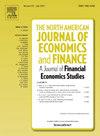Cross-asset contagion and risk transmission in global financial networks
IF 3.9
3区 经济学
Q1 BUSINESS, FINANCE
North American Journal of Economics and Finance
Pub Date : 2025-07-24
DOI:10.1016/j.najef.2025.102511
引用次数: 0
Abstract
This research examines cross-asset contagion and risk transmission by modeling global financial markets as a dynamic network, integrating equities, currencies, commodities, and cryptocurrencies. Using extreme value theory and tail-dependent copulas, we develop novel measures of contagion centrality and risk pathways, uncovering a persistent core-periphery structure where central assets exhibit shock-absorber properties during crises, while peripheral nodes amplify systemic fragility. Our findings reveal that financial contagion intensifies under stress, with enduring post-crisis interconnectedness, challenging traditional diversification strategies. Crucially, network topology-not just asset class-determines vulnerability: central assets demonstrate resilience to tail risks, whereas peripheral nodes face heightened susceptibility. These insights have profound implications for systemic risk monitoring, suggesting regulators prioritize real-time tracking of core-periphery linkages, while investors adjust hedging strategies to account for nonlinear contagion channels. The study advances financial network theory by unifying cross-asset spillovers within a topological framework and offers actionable tools for crisis mitigation in interconnected markets.
全球金融网络中的跨资产传染与风险传导
本研究通过将全球金融市场建模为一个动态网络,整合股票、货币、商品和加密货币,研究了跨资产传染和风险传导。利用极值理论和尾依赖联结,我们开发了传染中心性和风险路径的新措施,揭示了一个持续的核心-外围结构,其中中心资产在危机期间表现出减震器特性,而外围节点则放大了系统脆弱性。我们的研究结果表明,金融传染在压力下加剧,危机后的相互关联性持续存在,挑战了传统的多元化战略。至关重要的是,网络拓扑——不仅仅是资产类别——决定了脆弱性:中心资产表现出对尾部风险的弹性,而外围节点则面临更高的敏感性。这些见解对系统风险监测具有深远的影响,建议监管机构优先考虑核心与外围联系的实时跟踪,而投资者则调整对冲策略以考虑非线性传染渠道。该研究通过在拓扑框架内统一跨资产溢出来推进金融网络理论,并为相互关联的市场中的危机缓解提供了可行的工具。
本文章由计算机程序翻译,如有差异,请以英文原文为准。
求助全文
约1分钟内获得全文
求助全文
来源期刊
CiteScore
7.30
自引率
8.30%
发文量
168
期刊介绍:
The focus of the North-American Journal of Economics and Finance is on the economics of integration of goods, services, financial markets, at both regional and global levels with the role of economic policy in that process playing an important role. Both theoretical and empirical papers are welcome. Empirical and policy-related papers that rely on data and the experiences of countries outside North America are also welcome. Papers should offer concrete lessons about the ongoing process of globalization, or policy implications about how governments, domestic or international institutions, can improve the coordination of their activities. Empirical analysis should be capable of replication. Authors of accepted papers will be encouraged to supply data and computer programs.

 求助内容:
求助内容: 应助结果提醒方式:
应助结果提醒方式:


